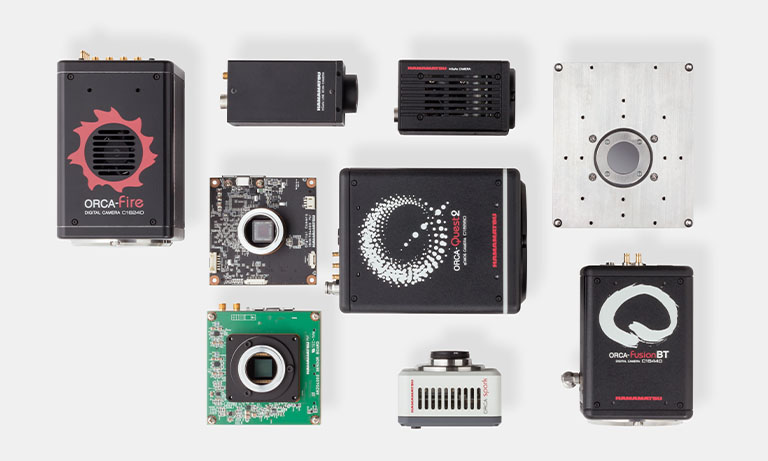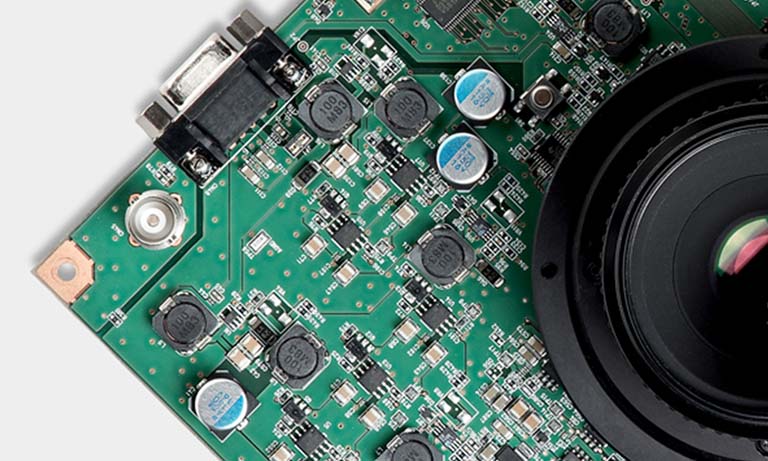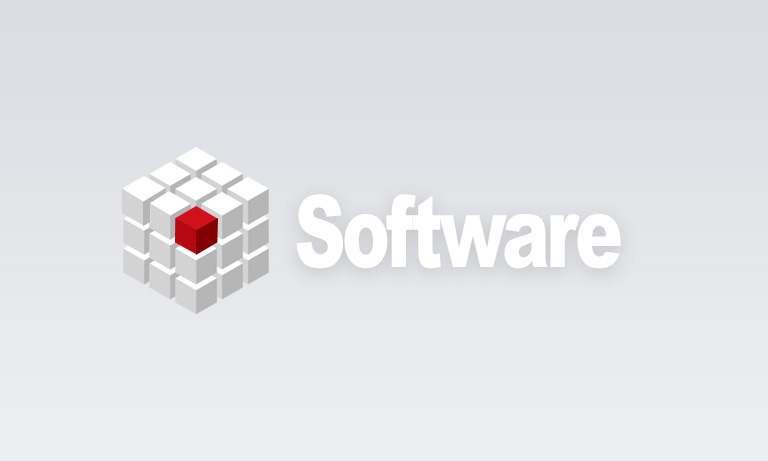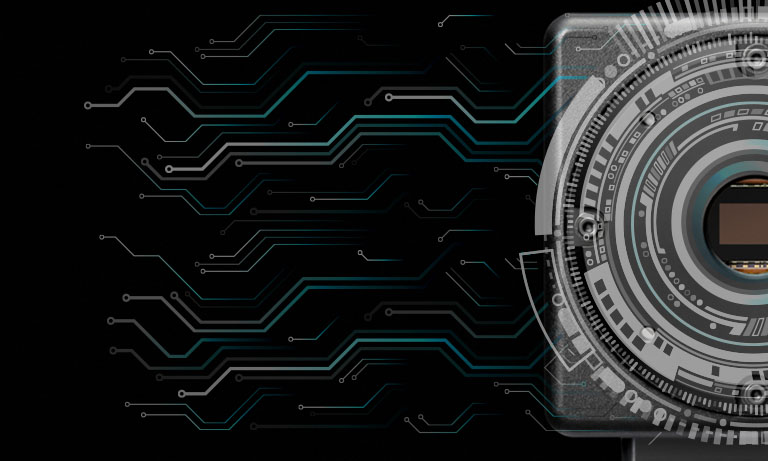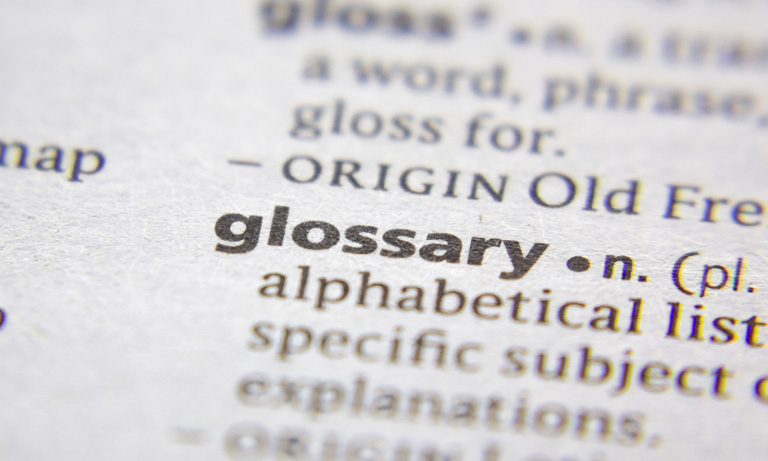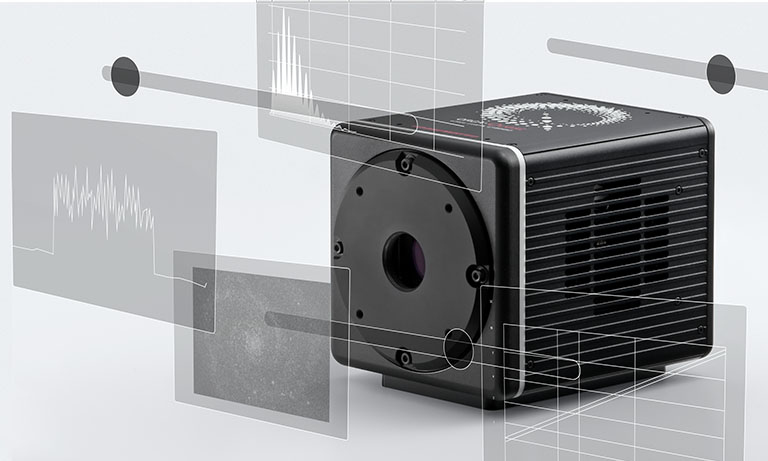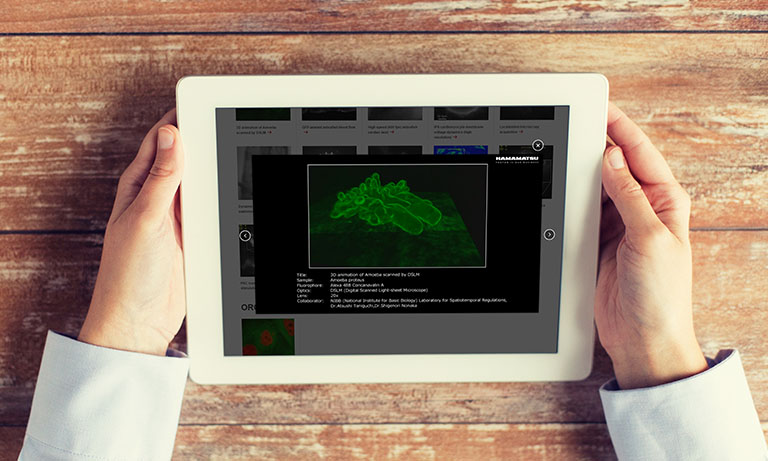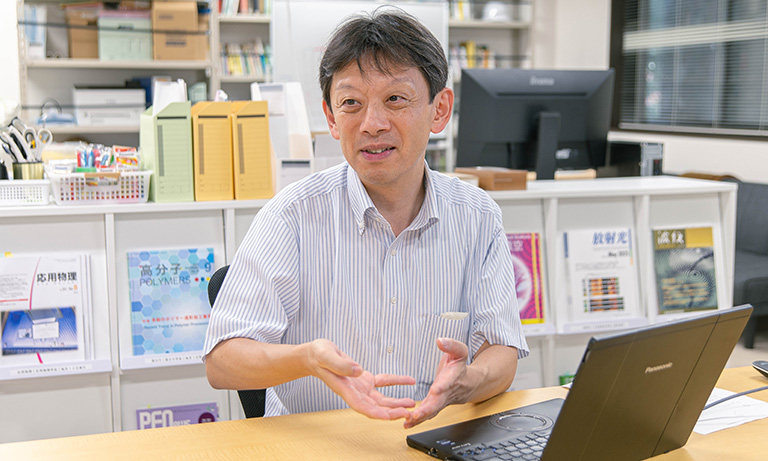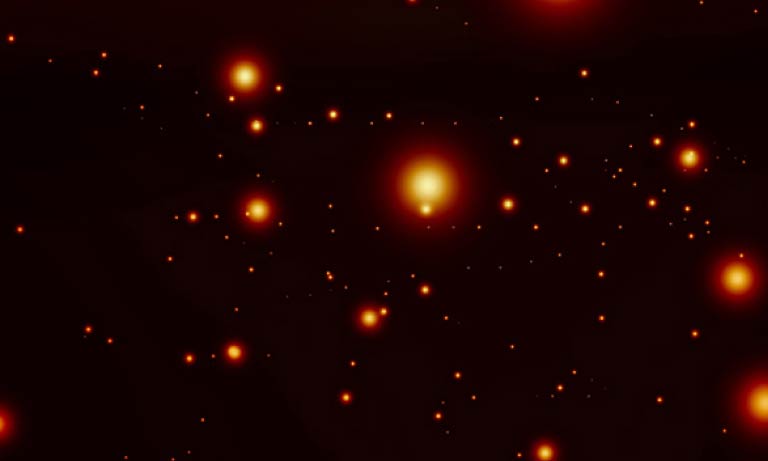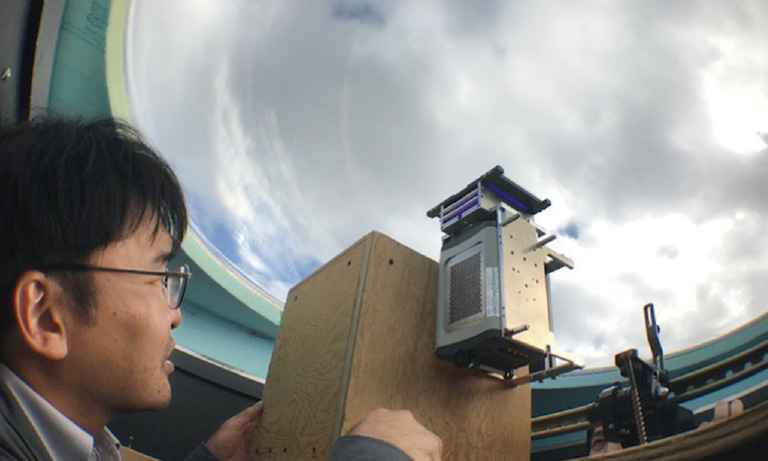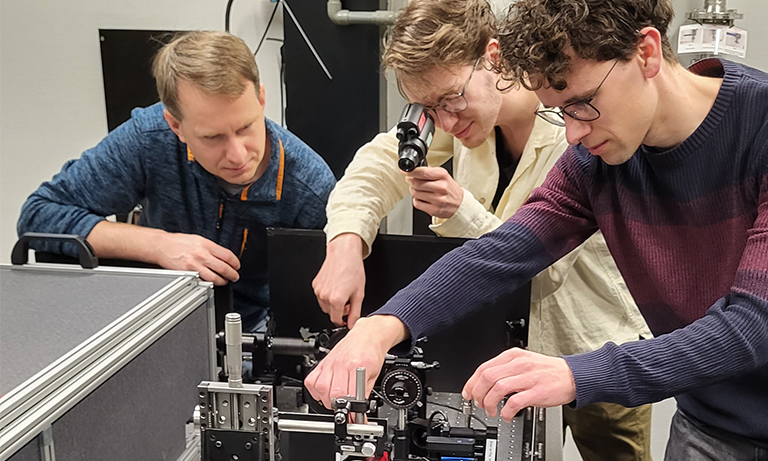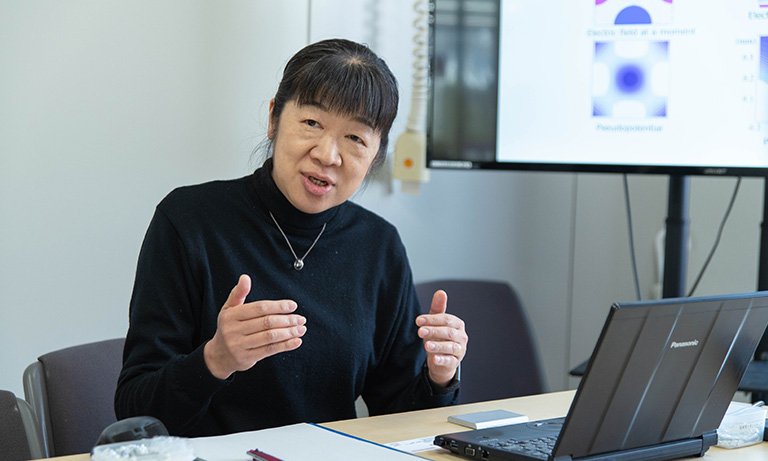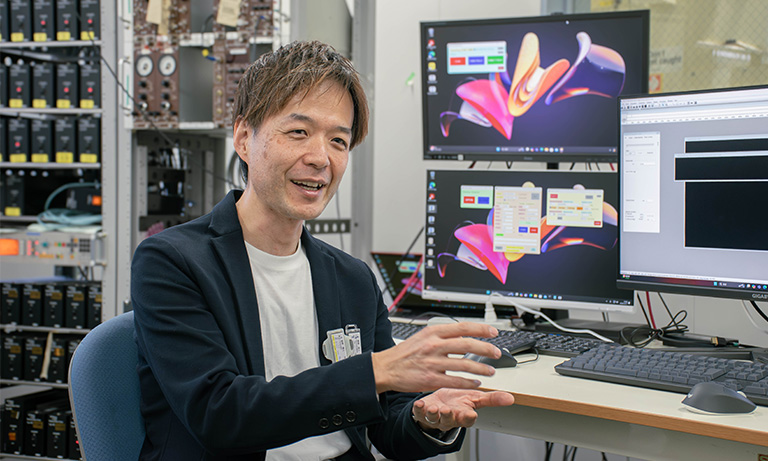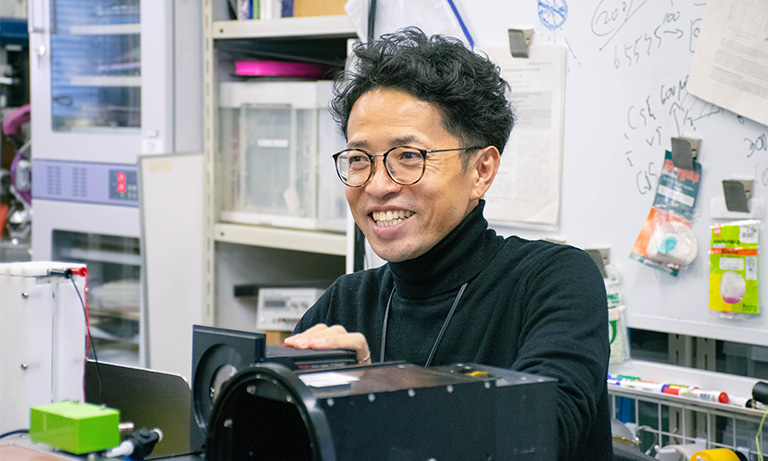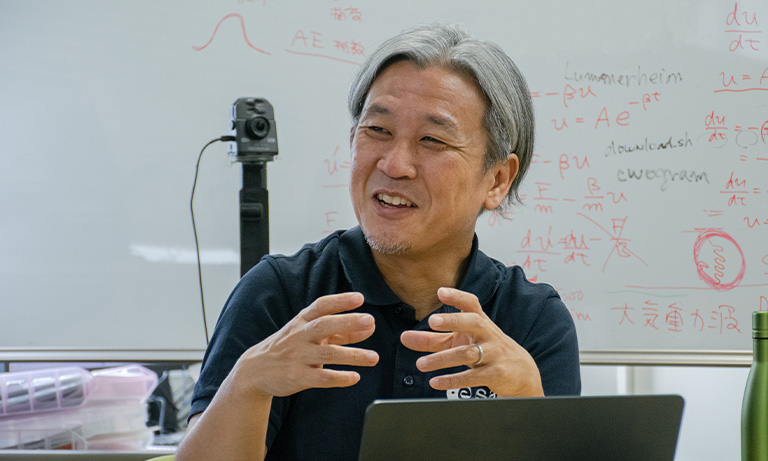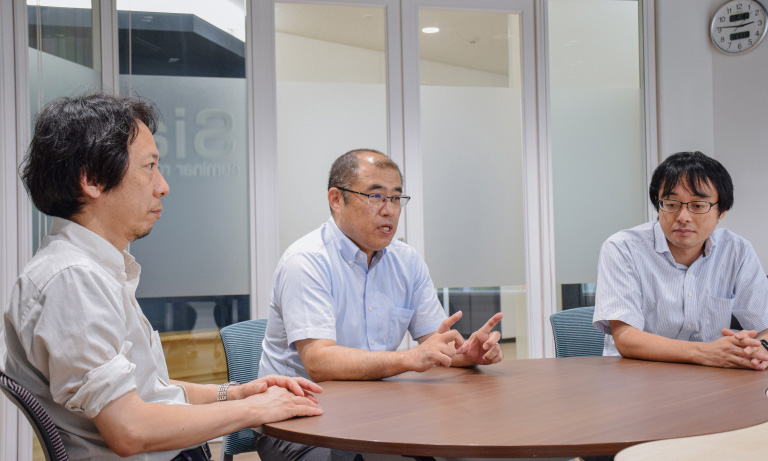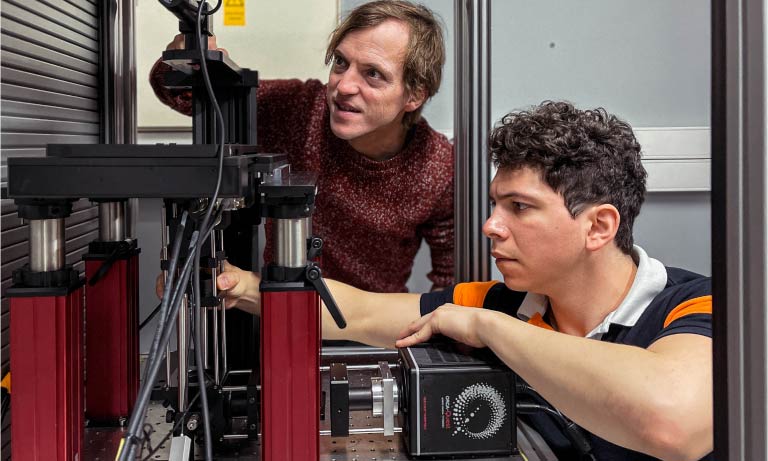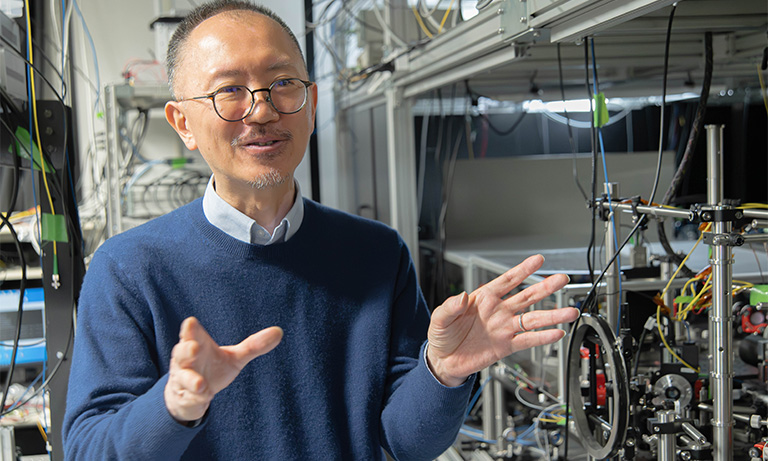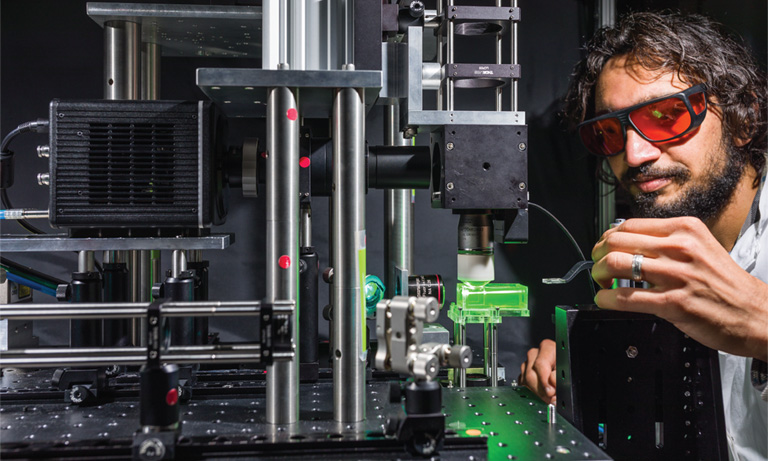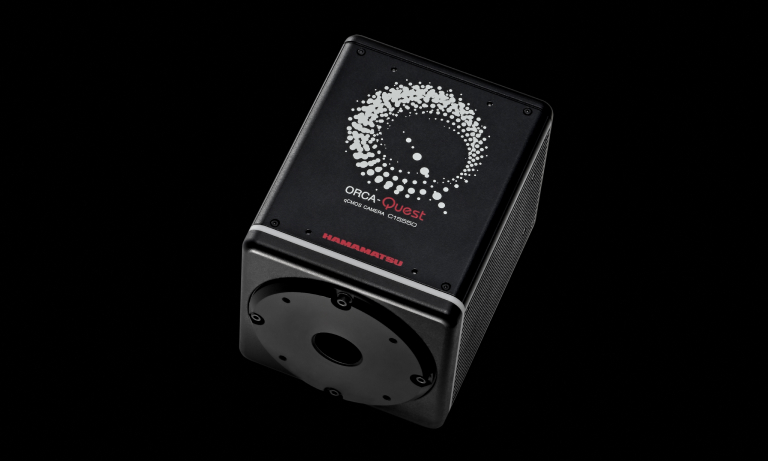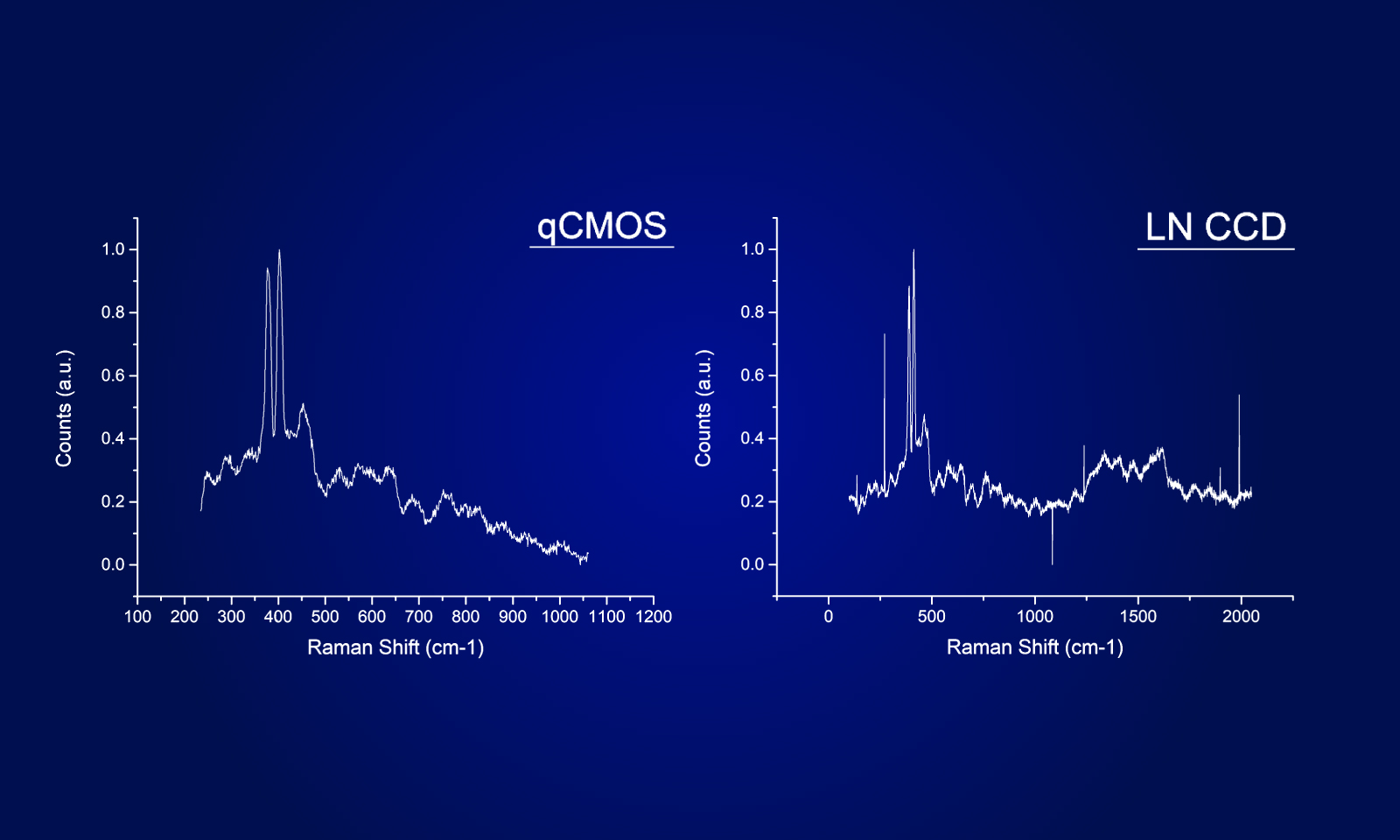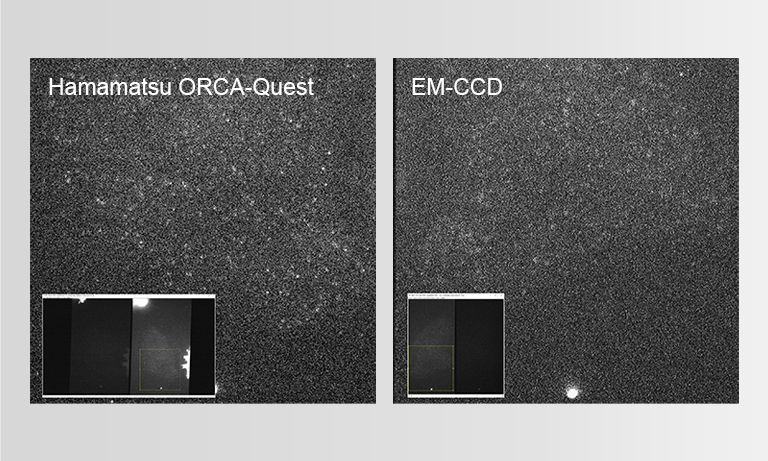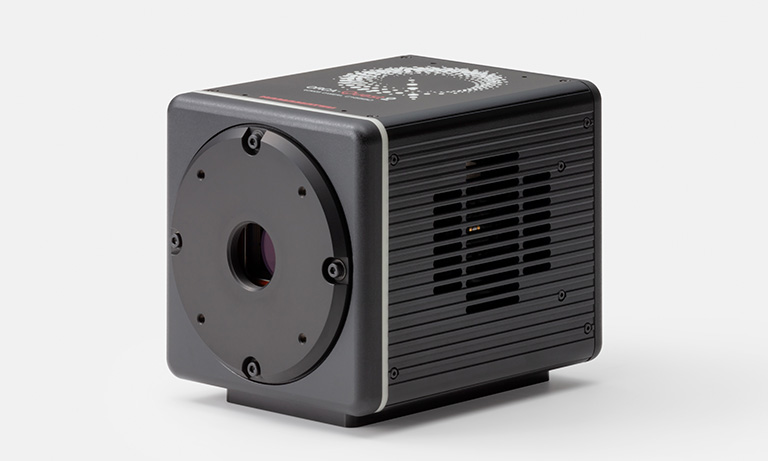Japan (JA)
国・地域を選択してください。
qCMOS®カメラ vs EM-CCDカメラ vol. 1 – フォトンカウンティングカメラの性能比較
ニーズに応じた科学計測用カメラを提供する際、極微弱光領域の計測においては超高感度なEM-CCD(Electron multiplying CCD)カメラ、比較的明るい領域では多画素、高速、高ダイナミックレンジなsCMOS(scientific CMOS)カメラであるというのが、従来のトレンドでした。その中で、CMOS技術はノイズ特性などにおいて発展を続け、イメージセンサの新たな時代の幕開けとなるqCMOS(quantitative CMOS)センサを搭載したカメラが弊社よりリリースされました。
qCMOSカメラは、その極限の低ノイズ性能により究極の定量イメージングを実現する、超高感度カメラに位置づけされます。そのため、同様に超高感度カメラであるEM-CCDカメラと比べた際に、ご自身のアプリケーションにとってどちらが最適であるか判断する必要があります。本ページではqCMOSカメラとEM-CCDカメラの比較を行うことで、適切なカメラを選択するための助けとなることを目的としています。
センサ技術と光子検出性能
本セクションでは、qCMOS、EM-CCDのセンサ技術、光子検出性能の比較を行うため、信号取得から出力までのフローを比較します。
図1に、カメラにおける信号取得からデジタル出力までのフローを示します。センサに入射したフォトンは、センサの量子効率に従い、光電子に変換されます。その後、その光電子がFDA(Floating diffusion Amplifier)により電圧に変換、増幅され、さらにADC(Analog-to-Digital Converter)によりデジタル値に変換され、出力されます。
科学計測用カメラでは、このフローにおけるノイズ特性が、高感度計測に大きく影響します。
超高感度カメラでは光電子信号に対して、デジタル変換における読み出しノイズ(カメラノイズ)をいかに小さくするかが重要となります。

図1 カメラにおける信号取得からデジタル出力までのフロー
qCMOSカメラ、EM-CCDカメラでは、それぞれ異なるアプローチで読出しノイズを下げることにより、1光電子レベルの信号を検出可能としています。
qCMOSカメラでは、極微細なCMOS回路技術により、極限の低読み出しノイズを実現しています(詳細はWhitepaperを参照)。これにより、図2のように、光電子が1個、2個、3個、…という信号をそれぞれ読み出す際、qCMOSの読み出しノイズはその信号よりも十分に小さく、最終的な出力結果から光電子数が1個、2個、3個であったと識別できます。このようにqCMOSカメラでは、入力光電子数を識別できるほどの究極の定量イメージングを可能としています。
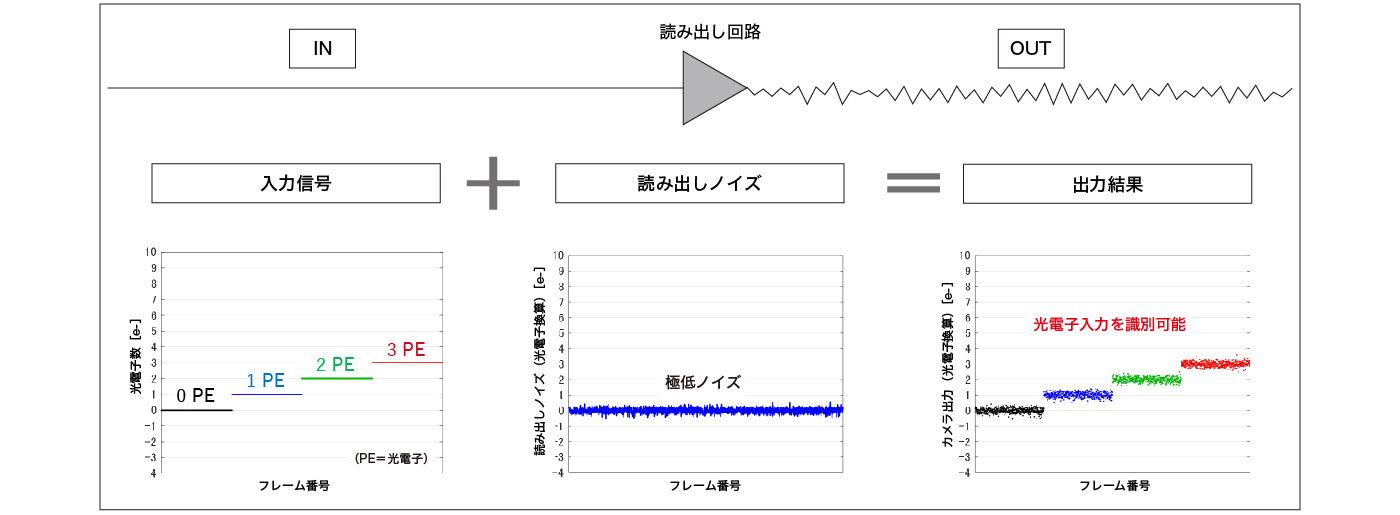
図2 qCMOSカメラにおける出力プロセスと光電子数識別
一方、EM-CCDでは、読み出しノイズ自体は大きいものの、図3のように光電子を電子増倍機構により増倍することで信号を大きくし、相対的に読み出しノイズを極限まで小さくしています。
しかし、増倍を用いるEM-CCDのような検出器では、信号を増倍した際に増倍ゆらぎ(Excess noise)とよばれる大きなノイズが加わってしまい、元の光電子入力を識別することができなくなります。このように、EM-CCDカメラは増倍を用いて読み出しノイズを相対的に小さくすることで1光子レベルの信号を検出することを可能としていますが、増倍ゆらぎの影響により定量性が失われてしまいます。

図3 EM-CCDカメラにおける出力プロセスと光電子数識別
表1に、本セクションで説明したqCMOSカメラとEM-CCDカメラの特長を比較しまとめました。
| qCMOSカメラ | EM-CCDカメラ | |
|---|---|---|
| 読出しノイズ | <0.3 electron rms | <0.1 electron with EM gain |
| 電子増倍機構 | 無し | 有り |
| 光子検出性能 | 0、1、2、3、… | 0 または 1以上 |
表1 qCMOSカメラ、EM-CCDカメラの特徴比較
また、qCMOSカメラとEM-CCDカメラの比較として、実際の撮像例を示します。
電子増倍を用いていないqCMOSカメラでは、EM-CCDカメラに比べフレームごとの画像の乱れが小さく、定量性の高いイメージングとなっていることが分かります。
SNR(Signal to Noise ratio)とピクセルサイズ
本セクションでは、カメラ性能の定量的な議論に代表的に用いられるSNR(Signal to Noise ratio)により、qCMOSカメラとEM-CCDカメラの比較を行います。
図4にSNRの計算式を示します。(ここでは、暗電流やEM-CCDにおけるCIC(Clock induced charge)ノイズなどを省いています。)
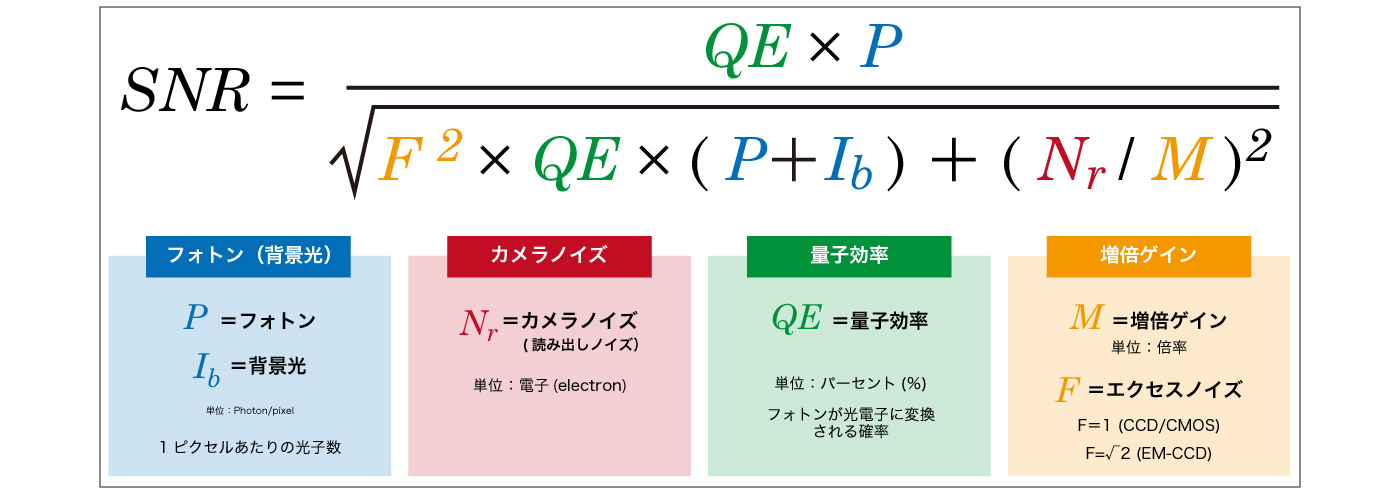
図4 SNRの計算式
SNRはセンサへの入射光量に依存しており、複数のカメラを入射光量別に比較する際には、比較条件として、
- 画素あたりの光量が等しいとき
- センサ面積あたりの光量が等しいとき
の二つに分けられます。
図5に、1画素あたりの光量が等しいとき、図6に、センサ面積あたりの光量が等しいときの、 qCMOS(ORCA-Quest 2)、EM-CCD、Gen III sCMOS (ORCA-Fusion BT、ORCA-Questの前世代のカメラ) を比較したSNRグラフを示します。本グラフは、ピクセルサイズ6.5 μmの、ノイズの一切無い、QE100%の仮想的なPerfect cameraのSNRを1とした比SNR(Relative SNR)グラフです。
1画素あたりの光量が等しい場合(図5)を見てみます。このケースは、各カメラの画素サイズに応じた最適な光学系を構築した場合を想定しています。CMOSカメラでは、読み出しノイズが光量によらず一定のため、光量が小さくなるとSNRも小さくなっていきます。一方、EM-CCDカメラでは、増倍を用いて読み出しノイズを極限に小さくするため、光量によってSNRはほとんど変化しませんが、増倍ゆらぎが常に存在するため光量が大きい領域ではCMOSカメラに比べ小さい値となります。そのため、光量が大きい領域ではsCMOSカメラ、光量が小さい領域ではEM-CCDカメラが優位である、というのが従来の常識となっていました。しかし、近年のCMOS技術の発展により、qCMOSカメラは0.1 photons/pixel/frameという極微弱光領域においてEM-CCDカメラと同等のSNRを示しています。
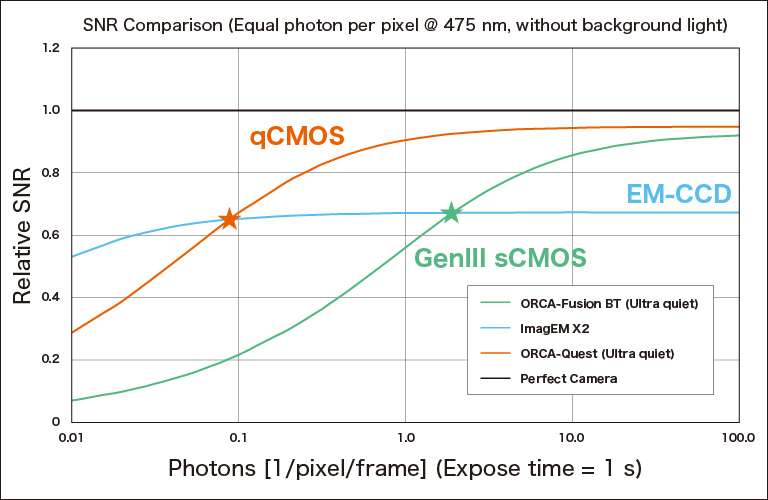
図5 1画素あたりの光量が等しいときのSNR比較
次に、センサ面積あたりの光量が等しい場合(図6)を見てみます。このケースは、光学系を変えず、カメラを変えた場合を想定しています。CMOSカメラはEM-CCDカメラに比べピクセルサイズが小さく画素当たりの光量が小さくなるため、本条件ではビニング機能を用いて1画素単位に同等の光量が入った場合のSNRも含んだ比較を載せています。
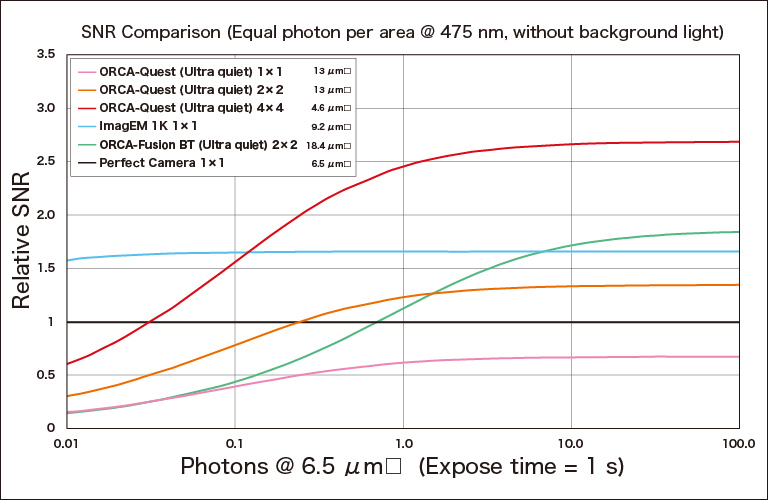
図6 センサ面積あたりの光量が等しいときのSNR比較
表2に比較条件と、条件に該当するケースを記載します。CMOSセンサではその構造上、N×Nビニングを行った場合、ビニング画素の読み出しノイズは、単一画素のノイズに比べてN倍に増加してしまいます。そのため、画素サイズの大きいカメラからqCMOSカメラに置き換える場合、ビニングを用いずにqCMOSカメラの画素サイズに合った最適な光学系を構築し、その性能を最大限に発揮したうえで比較することが推奨されます。
| 比較条件 | 1画素あたりの光量が等しい | センサ面積あたりの光量が等しい |
| ケース | 各カメラに最適な光学系を構築した場合の比較 | 光学系を変えずに、カメラをそのまま置き換えた場合の比較 |
表2 SNR比較条件と該当するケース
qCMOSカメラの汎用性
qCMOSカメラとEM-CCDカメラを比較した際に、qCMOSカメラのメリットとして一つ挙げられるのがその汎用性の高さにあります。qCMOSカメラは、EM-CCDカメラに比肩する極限の低ノイズに加え、従来のsCMOSカメラの長所を兼ね備えているハイブリッドなカメラです。
- 低速フレームレートにおいて、光子数識別も可能とする究極の定量性をもった超高感度なイメージング
- 高速フレームレートかつ高感度なイメージング
- 高ダイナミックレンジかつ高感度イメージングの実現(EM-CCDカメラは電子増倍を用いるためダイナミックレンジを犠牲とする)
- 多画素による広視野、高解像イメージング
- 長時間露光用途に使用可能な、CMOSカメラの中でフラッグシップとなる暗電流性能
EM-CCDカメラが優位な領域
図5, 6の相対SNR比較から、0.1 photons/pixel/frame以下の極微弱光領域において、EM-CCDカメラがqCMOSカメラに勝るSNRを示していることが分かります。ただ、0.1 photons/pixel/frameにおけるSNRの”絶対値”は非常に小さく、サンプルはノイズに埋もれてほとんど見えません。図7に、浜松ホトニクスのカメラシミュレーションラボによる、テストチャートサンプルの画像シミュレーション(入射光量0.1、0.5、1.0、10 photons/pixel/frame、波長475nm、撮像エリア512×512ピクセル、背景光無し、自動スケール)を示します。この画像のように0.1 photons/pixel/frameにおいてはどちらのカメラでもサンプルをほとんど検出できず、この光量におけるSNRの優位性というものは実質的に意味がありません。
より実践的なシミュレーションとして、入射光量に対して一定の割合の背景光がある結果を参考として掲載します。
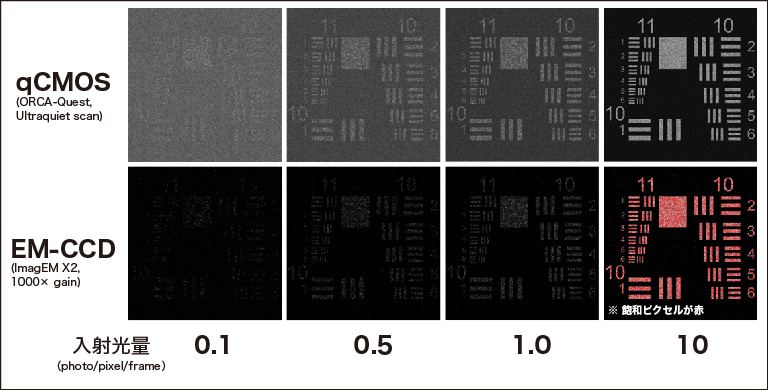
図7 テストチャートサンプルを用いた低光量におけるカメラシミュレーション
EM-CCDカメラでは電子増倍機構により読み出しノイズを極限まで小さくするため、図7のように背景光が無い場合、ダーク領域においてノイズはほとんど見られません。ただ、背景光がある現実的なケースを想定した場合にはその背景光も増倍されてしまうため、ダーク領域にノイズが顕著に表れます。
このような極微弱光領域におけるアプリケーションでは、一般的には露光時間を延ばし1 photons/pixel/frame以上の観測可能なSNRでのイメージングを行っています。その際、EM-CCDカメラはセンサの高冷却により極低暗電流を実現しているため、このような極微弱光領域かつ長時間露光でのイメージングにおいては依然qCMOSカメラに対し優位性を持っています。
EM-CCDは成熟したセンサ技術であるため、CMOS技術の発展によりその優位性を失いつつあります。しかし、上に述べたように依然として、実験における光量と露光時間に応じてqCMOSカメラとEM-CCDカメラのどちらが優れたSNRを示すか適宜判断する必要があります。
最後に
qCMOSカメラは、EM-CCDカメラに比肩する極限の低ノイズに加え、従来のsCMOSカメラの長所を兼ね備えているハイブリッドなカメラであり、従来の光科学計測に新たなブレークスルーをもたらすカメラです。
qCMOSセンサは日々進歩を続けるCMOS技術により、さらなる発展が見込まれます。qCMOSカメラという新たな技術と、EM-CCDカメラを始めとした光子検出性能を持つ検出器との性能比較を行うことで、最適な検出器をご自身で選定できるよう本ページがその走りとなればと思います。
- Confirmation
-
It looks like you're in the . If this is not your location, please select the correct region or country below.
You're headed to Hamamatsu Photonics website for JP (Japanese). If you want to view an other country's site, the optimized information will be provided by selecting options below.
In order to use this website comfortably, we use cookies. For cookie details please see our cookie policy.
- Cookie Policy
-
This website or its third-party tools use cookies, which are necessary to its functioning and required to achieve the purposes illustrated in this cookie policy. By closing the cookie warning banner, scrolling the page, clicking a link or continuing to browse otherwise, you agree to the use of cookies.
Hamamatsu uses cookies in order to enhance your experience on our website and ensure that our website functions.
You can visit this page at any time to learn more about cookies, get the most up to date information on how we use cookies and manage your cookie settings. We will not use cookies for any purpose other than the ones stated, but please note that we reserve the right to update our cookies.
1. What are cookies?
For modern websites to work according to visitor’s expectations, they need to collect certain basic information about visitors. To do this, a site will create small text files which are placed on visitor’s devices (computer or mobile) - these files are known as cookies when you access a website. Cookies are used in order to make websites function and work efficiently. Cookies are uniquely assigned to each visitor and can only be read by a web server in the domain that issued the cookie to the visitor. Cookies cannot be used to run programs or deliver viruses to a visitor’s device.
Cookies do various jobs which make the visitor’s experience of the internet much smoother and more interactive. For instance, cookies are used to remember the visitor’s preferences on sites they visit often, to remember language preference and to help navigate between pages more efficiently. Much, though not all, of the data collected is anonymous, though some of it is designed to detect browsing patterns and approximate geographical location to improve the visitor experience.
Certain type of cookies may require the data subject’s consent before storing them on the computer.
2. What are the different types of cookies?
This website uses two types of cookies:
- First party cookies. For our website, the first party cookies are controlled and maintained by Hamamatsu. No other parties have access to these cookies.
- Third party cookies. These cookies are implemented by organizations outside Hamamatsu. We do not have access to the data in these cookies, but we use these cookies to improve the overall website experience.
3. How do we use cookies?
This website uses cookies for following purposes:
- Certain cookies are necessary for our website to function. These are strictly necessary cookies and are required to enable website access, support navigation or provide relevant content. These cookies direct you to the correct region or country, and support security and ecommerce. Strictly necessary cookies also enforce your privacy preferences. Without these strictly necessary cookies, much of our website will not function.
- Analytics cookies are used to track website usage. This data enables us to improve our website usability, performance and website administration. In our analytics cookies, we do not store any personal identifying information.
- Functionality cookies. These are used to recognize you when you return to our website. This enables us to personalize our content for you, greet you by name and remember your preferences (for example, your choice of language or region).
- These cookies record your visit to our website, the pages you have visited and the links you have followed. We will use this information to make our website and the advertising displayed on it more relevant to your interests. We may also share this information with third parties for this purpose.
Cookies help us help you. Through the use of cookies, we learn what is important to our visitors and we develop and enhance website content and functionality to support your experience. Much of our website can be accessed if cookies are disabled, however certain website functions may not work. And, we believe your current and future visits will be enhanced if cookies are enabled.
4. Which cookies do we use?
There are two ways to manage cookie preferences.
- You can set your cookie preferences on your device or in your browser.
- You can set your cookie preferences at the website level.
If you don’t want to receive cookies, you can modify your browser so that it notifies you when cookies are sent to it or you can refuse cookies altogether. You can also delete cookies that have already been set.
If you wish to restrict or block web browser cookies which are set on your device then you can do this through your browser settings; the Help function within your browser should tell you how. Alternatively, you may wish to visit www.aboutcookies.org, which contains comprehensive information on how to do this on a wide variety of desktop browsers.
5. What are Internet tags and how do we use them with cookies?
Occasionally, we may use internet tags (also known as action tags, single-pixel GIFs, clear GIFs, invisible GIFs and 1-by-1 GIFs) at this site and may deploy these tags/cookies through a third-party advertising partner or a web analytical service partner which may be located and store the respective information (including your IP-address) in a foreign country. These tags/cookies are placed on both online advertisements that bring users to this site and on different pages of this site. We use this technology to measure the visitors' responses to our sites and the effectiveness of our advertising campaigns (including how many times a page is opened and which information is consulted) as well as to evaluate your use of this website. The third-party partner or the web analytical service partner may be able to collect data about visitors to our and other sites because of these internet tags/cookies, may compose reports regarding the website’s activity for us and may provide further services which are related to the use of the website and the internet. They may provide such information to other parties if there is a legal requirement that they do so, or if they hire the other parties to process information on their behalf.
If you would like more information about web tags and cookies associated with on-line advertising or to opt-out of third-party collection of this information, please visit the Network Advertising Initiative website http://www.networkadvertising.org.
6. Analytics and Advertisement Cookies
We use third-party cookies (such as Google Analytics) to track visitors on our website, to get reports about how visitors use the website and to inform, optimize and serve ads based on someone's past visits to our website.
You may opt-out of Google Analytics cookies by the websites provided by Google:
https://tools.google.com/dlpage/gaoptout?hl=en
As provided in this Privacy Policy (Article 5), you can learn more about opt-out cookies by the website provided by Network Advertising Initiative:
http://www.networkadvertising.org
We inform you that in such case you will not be able to wholly use all functions of our website.
Close
